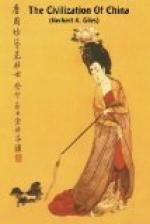The last emperor of the Ming dynasty meant well, but succumbed to the stress of circumstances. Eunuchs and over-taxation brought about the stereotyped consequence—rebellion; rebellion, too, headed by an able commander, whose successive victories soon enabled him to assume the Imperial title. In the capital all was confusion. The treasury was empty; the garrison were too few to man the walls; and the ministers were anxious to secure each his own safety. On April 9, 1644, Peking fell. During the previous night the emperor, who had refused to flee, slew the eldest princess, commanded the empress to commit suicide, and sent his three sons into hiding. At dawn the bell was struck for the court to assemble; but no one came. His Majesty then ascended the Coal Hill in the palace grounds, and wrote a last decree on the lapel of his robe: “WE, poor in virtue and of contemptible personality, have incurred the wrath of God on high. My ministers have deceived me. I am ashamed to meet my ancestors; and therefore I myself take off my crown, and with my hair covering my face await dismemberment at the hands of the rebels. Do not hurt a single one of my people.” He then hanged himself, as also did one faithful eunuch; and his body, together with that of the empress, was reverently encoffined by the rebels.
So ended the Ming dynasty, of glorious memory, but not in favour of the rebel commander, who was driven out of Peking by the Manchus and was ultimately slain by local militia in a distant province.
The subjugation of the empire by the victors, who had the disadvantage of being an alien race, was effected with comparative ease and rapidity. It was carried out by a military occupation of the country, which has survived the original necessity, and is part of the system of government at the present day. Garrisons of Tartar troops were stationed at various important centres of population, each under the command of an officer of the highest military grade, whose duty it was to co-operate with, and at the same time watch and act as a check upon, the high authorities employed in the civil administration. Those Tartar garrisons still occupy the same positions; and the descendants of the first battalions, with occasional reinforcements from Peking, live side by side and in perfect harmony with the strictly Chinese populations, though the two races do not intermarry except in very rare cases. These Bannermen, as they are called, in reference to eight banners or corps under which they are marshalled, may be known by their square heavy faces, which contrast strongly with the sharper and more astute-looking physiognomies of the Chinese. They speak the dialect of Peking, now regarded as the official or “mandarin” language, just as the dialect of Nanking was, so long as that city remained the capital of the empire.




